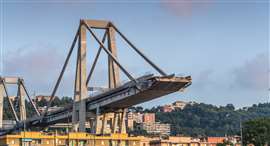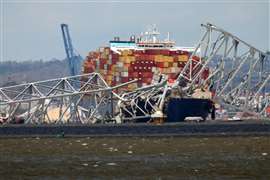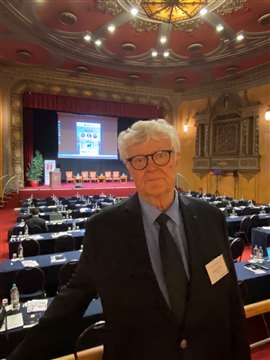Europe’s ageing bridges are crumbling. What can be done to prevent collapses?
24 April 2024
There are approximately two million bridges in Europe, a tenth of which are in what could be described, without hyperbole, as a potentially dangerous condition.
 Italy’s Morandi Bridge in Genoa, which collapsed in 2018. Photo: Adobe Stock
Italy’s Morandi Bridge in Genoa, which collapsed in 2018. Photo: Adobe Stock
This according to Christian Tridon, founder of the Eurobridge conference, an annual event held in Brussels for the past three years.
At the conference earlier this month, Tridon referenced the collapse of the Francis Scott Key Bridge in Baltimore, USA, during his opening remarks.
While the collapse was not necessarily due to poor maintenance, he said, it has nonetheless highlighted the social and economic importance to society of these structures.
As this article is written, only a very small number of vessels have been able to enter and exit the busy Port of Baltimore since the accident, in which a cargo ship lost power and collided with one of the bridge’s piers.
Another example of the devastating effects of a bridge collapse came in 2018, when the Morandi Bridge in Genoa, Italy, collapsed during a storm, killing 43 people and leaving many hundreds homeless.
Corrosion to the bridge’s steel cables was said to have contributed to the bridge’s collapse, but a basic failure to properly survey and maintain the structure is behind the tragedy.
Tridon told Construction Europe, “The cost of the collapse was enormous, especially for the port – way more than the bridge’s real value when it was built.”
Tridon established the Eurobridge conference to highlight precisely the problem demonstrated by these and other bridge incidents – that the surveying and rehabilitation of bridges must be made a higher priority for European lawmakers.
Ageing and deteriorating structures
“In the 1950s,” he says, “we started to build many bridges in Europe. Now these structures are 70 or 80 years old.
 The Francis Scott Key Bridge in Baltimore, USA, which partially collapsed when hit by a cargo ship. Photo: Reuters
The Francis Scott Key Bridge in Baltimore, USA, which partially collapsed when hit by a cargo ship. Photo: Reuters
“With these structures, the reinforced concrete reacts with pollution, especially carbon dioxide, which can penetrate the concrete – unless it’s well protected – and trigger corrosion.
“The steel in the concrete will swell, then it will burst the concrete around it.
“All European countries are subjected to the ageing and deterioration of these structures, so a question we ask is are the bridges still able to support the loads of today’s transportation?
“The answer is usually no.”
One of the aims of the Eurobridge conference is to raise awareness of the potentially dangerous condition of bridges to the powers that be in Brussels.
To this end, Tridon is grateful for the support of FIEC, the European construction industry federation. In 2022, FIEC was instrumental in pushing through an amendment to EU regulations, which obliges member states to maintain the infrastructure of the TEN-T transport network, in a way that ensures it maintains a high level of service and safety during its lifetime.
On the flipside of this positive news, Tridon says the current political will is to increase the maximum load on bridges from 38 to 60 tonnes.
“But,” he insists, “bridges are already struggling to support 38 tonnes, so it seems complicated to reach 60.
“That’s why we wanted to alert Europe, with the help of FIEC, about this issue and we wanted to exchange experience, skills and knowledge, with other European engineers and European counties.”
Mandatory bridge surveying
 Christian Tridon, founder of the Eurobridge Conference
Christian Tridon, founder of the Eurobridge Conference
Tridon says, “All bridges potentially have a pathological issue. Some are already in poor condition and need to be checked closely, to see whether they need to be demolished or they can be rehabilitated. And we have the technology for this, although it is true that skills are somewhat lacking in this field.
“In Europe, we have classified some structures, from red [an immediate cause for concern], orange and green [good condition].
“But in France, we recently had a bridge collapse when it was classified as green.
“A bridge is a fragile structure and we must not forget those in good condition today, because that might not be the case tomorrow.
“The Eurobridge message is that it should be mandatory to regularly check all bridges, to be able to act before critical issues arise.”
While it’s concerning that around 10% of all European bridges are currently classified as being significantly deficient, it’s perhaps just as worrying to hear that 30% – which have been classified green – are not being regularly surveyed and/or maintained.
As Tridon says, “If you’re not going to the doctor, then you’re not thought to be sick – and if you’re not checking the bridges, then they’re not sick either… as far as we know.”
The total built value of all of Europe’s bridges is reported to be around €2 trillion (US$2.1 billion).
Tridon says, “We might expect to take 1.5% of this value for the annual maintenance of bridges, so that should represent €30 billion (US$30 billion) per year. We should plan for this.”
Unfortunately, Tridon cannot say how much is actually being spent on bridge surveying, repair and maintenance.
He is, however, the chairman of a working group within FIEC, which is now looking into these questions and is gathering data that he hopes could help prevent future bridge disasters in Europe.
|
STAY CONNECTED



Receive the information you need when you need it through our world-leading magazines, newsletters and daily briefings.
CONNECT WITH THE TEAM








